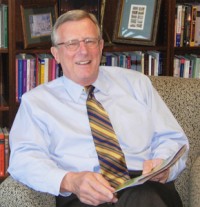Megachurch, mini-congregation: Pastoral care in the large congregation
This issue features a topic in which I have a personal interest—the megachurch (see Wanted: Megapastors), though I deplore the term and try never to use it. It is such a market-oriented word, so hurtful to the vast majority of ministers who work faithfully in congregations that do not approach “mega” dimensions except in spirit, courage, compassion and mission.
My special interest in John Dart’s report comes also from my friendship with the late Frank Harrington, who before he died unexpectedly and much too soon was the pastor of the largest congregation in my denomination. Atlanta’s Peachtree Presbyterian Church at one time listed 13,000 members. Dart quotes Jerry Van Marter, the Presbyterian communications officer, to the effect that Harrington resisted deleting a single name from the church roll. I would add that Frank Harrington was a terrific pastor, that he loved the Presbyterian Church, and that he led his congregation to impressive commitment to mission in new church development and in Habitat for Humanity projects, and was a major contributor to theological education.
Our article on megachurch leadership revived a mental conversation I had been having with Eugene Peterson, who was interviewed in our previous issue about pastoral ministry. Peterson declared that “pastoral work is best handled in a fairly small setting,” and he specified that “fairly small” means “somewhere between 50 and 500 people.” I bristled a bit a this, but eventually concluded that he is right. Good pastoral work happens in settings of under 500 people. If your congregation is larger than that, then it’s important to do something to create the dynamic of a smaller congregation.
I view my congregation as a network of smaller congregations, organized around fellowship, mission, education or personal need. And I regard my pastoral colleagues as pastors of those individual congregations. My task is to oversee the network of congregations and pay special attention to my colleagues—the staff itself being one of those smaller congregations of the church.
Peterson is right about the numbers. One person can be pastor to up to 500 people. Beyond 500, the inevitable bureaucratization will begin to work against community and pastoral care. When I was a pastor of a congregation of 100 people, I quickly knew every family and every member well and visited every home. In a church of 500, it took eight years before I knew every member and had visited their homes. In a church of 1,200, I eventually knew most of the people, and visited in a few homes. Now, serving a congregation approaching 5,000 members, I am gratified that the vast majority of those members are known by one of the church’s ministers.
But every Sunday after worship I see the smaller congregations gather in the corners of the sanctuary and throughout the building. Animated conversations begin to happen and lives are touched by the grace of God communicated in and through a small group, one of the many congregations in which pastoral care can and does happen.






